Top Challenges in Implementing a Global HR System and how to manage them
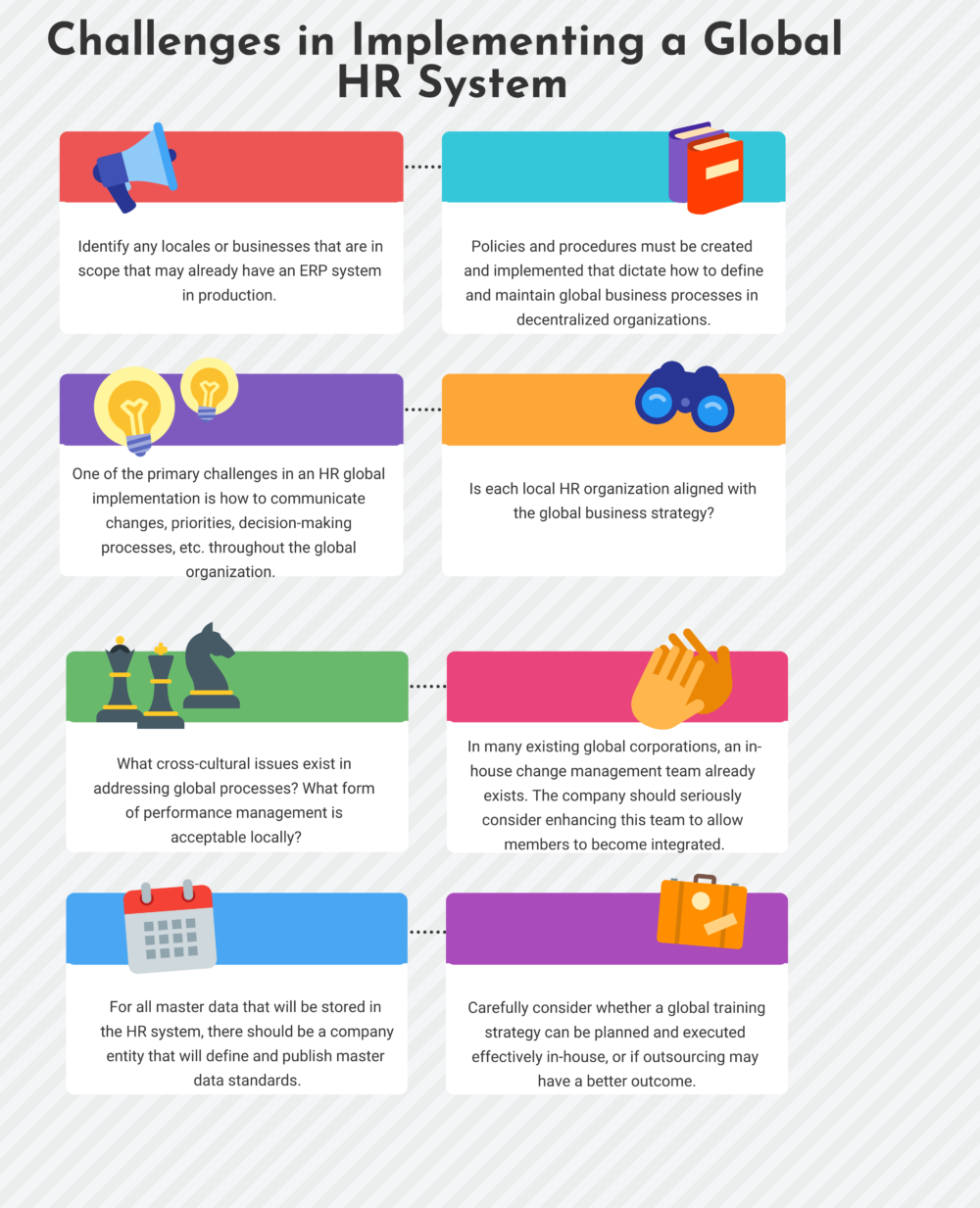
The Top Challenges in Implementing a Global HR System includes Integration with Existing ERP System, Global Process Management, Global Communication Strategies, Global and Team Organization, Cross-Cultural Processes, Global Change Management, Master Data Management, Global Training Strategies, Release Strategy, Global System Support, Single Instance vs. Multiple Instance Approach, Data Conversion, and Data Privacy.
The purpose of this guide is to provide a very brief overview of some design, configuration and process issues that should be considered when implementing a global Human Resources system. Please note that the items are listed in no specific order of importance or urgency, although there are certain design issues that should be decided upon or at least close to completion before other implementation steps can successfully proceed.
These items focus mainly on the HR-specific implementation issues encountered in different global projects.

Top Challenges in Implementing a Global HR System and how to manage them
1. Integration with Existing ERP System
Identify any locales or businesses that are in scope that may already have an ERP system in production. If any exist, then the configuration already designed in these systems should be considered in the global design. The existing systems will have accumulated ERP historical data; the businesses will most likely wish to retain the information in the new system, avoiding the need to convert historical data into the new HR system.
2. Global Process Management
Policies and procedures must be created and implemented that dictate how to define and maintain global business processes in decentralized organizations. Centralizing processes as much as possible can help maintain data integrity and consolidate resource requirements, but some processes are most effective when managed locally as an example, maintenance of organizational units and positions. This means that some processes that previously were handled centrally or did not exist at all will need to be managed locally. One example of this is creation and maintenance of positions and position attributes.
Conversely, some processes that were local or business unit specific may need to be centralized, either for the sake of efficiency or because of data integrity or control issues. An example of this might be cross-country assignments or country re-assignments or creation of new jobs and job attributes.
Based on processes that will be central and which will be local, begin to design a staffing plan based on historical volumes of work. For organizational management processes, which are new to many companies, it is best to be generous in staffing estimates, and critical that resources involved in the implementation be targeted for transition into the company business support process post-LIVE. Consider the number of resources that may be required in remote locations for the decentralized processes and identify the general skill sets required. Identify the procedures that will have to change due to centralization and/or localization.
3.Global Communication Strategies
One of the primary challenges in an HR global implementation is how to communicate changes, priorities, decision-making processes, etc. throughout the global organization. Some communication methodologies that have been successfully utilized are:
- Project website
- Project newsletter
- Weekly project status letters
- Regular team meetings
Define the core project team with representation from all regions as soon as possible. A global project can greatly benefit from a clear definition of responsibilities and tasks; consider a responsibility charter or a “partnership” document of some sort that clearly lists the tasks and responsibilities of the various teams and businesses. One example of a partnership document developed at a global company included a division between tasks and responsibilities of the central project management team and those of the local, country and business-specific teams throughout the world.
During design, configuration, and cutover phases, meetings with all team leads should be held weekly, at a minimum. All discussion items, decisions and key design issues should be documented and distributed.
4. Global and Team Organization
Is each local HR organization aligned with the global business strategy?
When staffing the implementation teams, consider the existing reporting relationships, i.e. to a global VP of HR or to business (functional vs. regional); also keep in mind that there may likely be changes based on centralization vs. decentralization of HR functions, both current and to-be.
- Based on the applications being implemented, there may need to be enhanced integration of HR and payroll organizations.
- The implementation team must be organized appropriately to support each global process.
- Define the appropriate team profile (mix of business employees and consultants).
- Define the reporting hierarchy for the project; also create a partnership document that defines every responsibility in the project as a global, local or both.
- Ensure that there is local infrastructure in place for network development and hardware deployment. If not available in remote regions, a strategy must be defined to support these areas.
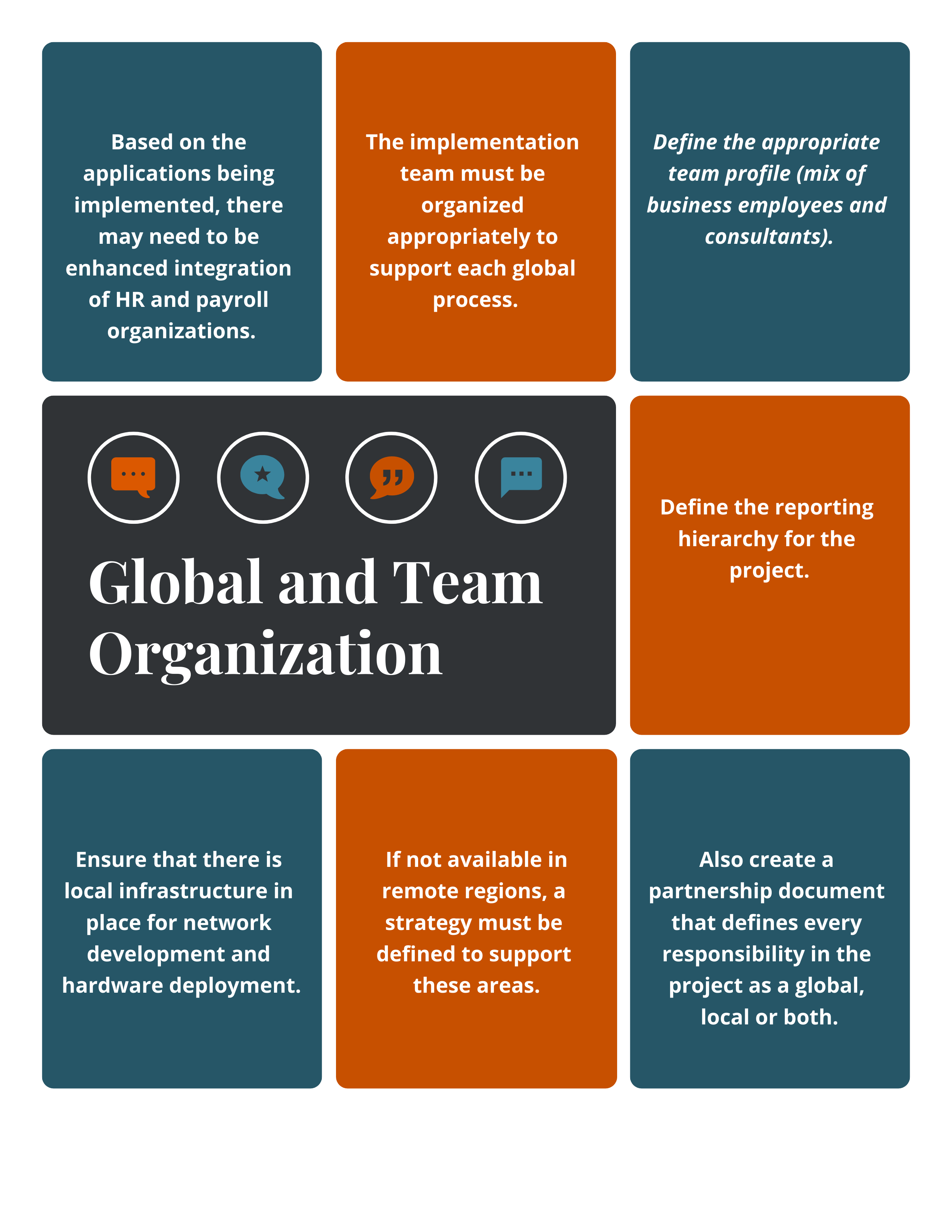
Global and Team Organization
5.Cross-Cultural Processes
What cross-cultural issues exist in addressing global processes? What form of performance management is acceptable locally? For example, will management embrace on-line performance appraisals, if necessary?
Will local employees be responsive to handling changes to their own data, if the process dictates?
6.Global Change Management
In many existing global corporations, an in-house change management team already exists. The company should seriously consider enhancing this team to allow members to become integrated with an implementation force and work together to identify change opportunities, design roll-out strategies for change processes, and implement the changes effectively. Alternately, outsourcing is an option in order to obtain qualified change management agents. The key point is that the change management agents should be a key part of the implementation team, not just resources that are peripherally involved when a crisis arises.
Identify the requirements for global organizational change management and how the resources will be integrated with the core implementation team.
7.Master Data Management
For all master data that will be stored in the HR system, there should be a company entity that will define and publish master data standards. This may be a core central team of project managers, but there should be representation from at least a regional (Europe, North America, Asia) perspective for all businesses within the company. The company global reporting and management requirements will drive at least some of this definition and the data standards. There should also be defined guidelines for allowed table entries where feasible.
Define how the organization will maintain master data standards; the roles, teams and business unit responsibilities within global organization as pertains to master data. Define audit reports and procedures that may be required to monitor critical data elements.
8.Global Training Strategies
Carefully consider whether a global training strategy can be planned and executed effectively in-house, or if outsourcing may have a better outcome. Some items to consider are listed below.
- What documentation will be considered global and what is local? Define who is responsible for developing documentation based on whether it is global or local in nature.
- Define documentation that may be centrally developed but must be modified for local use. (as an example, BPP baselines may be developed centrally but must be modified for local use)
- How will the organizations develop and maintain global documentation? Will resources be in-house or third party?
- The company must address any local variations in business process (by division, region; etc) and determine how to identify what the trainers need to train.
- How will the company manage the translation process?
- How will the company manage the delivery process?
- Consider conducting a survey to identify training needs and methodologies.
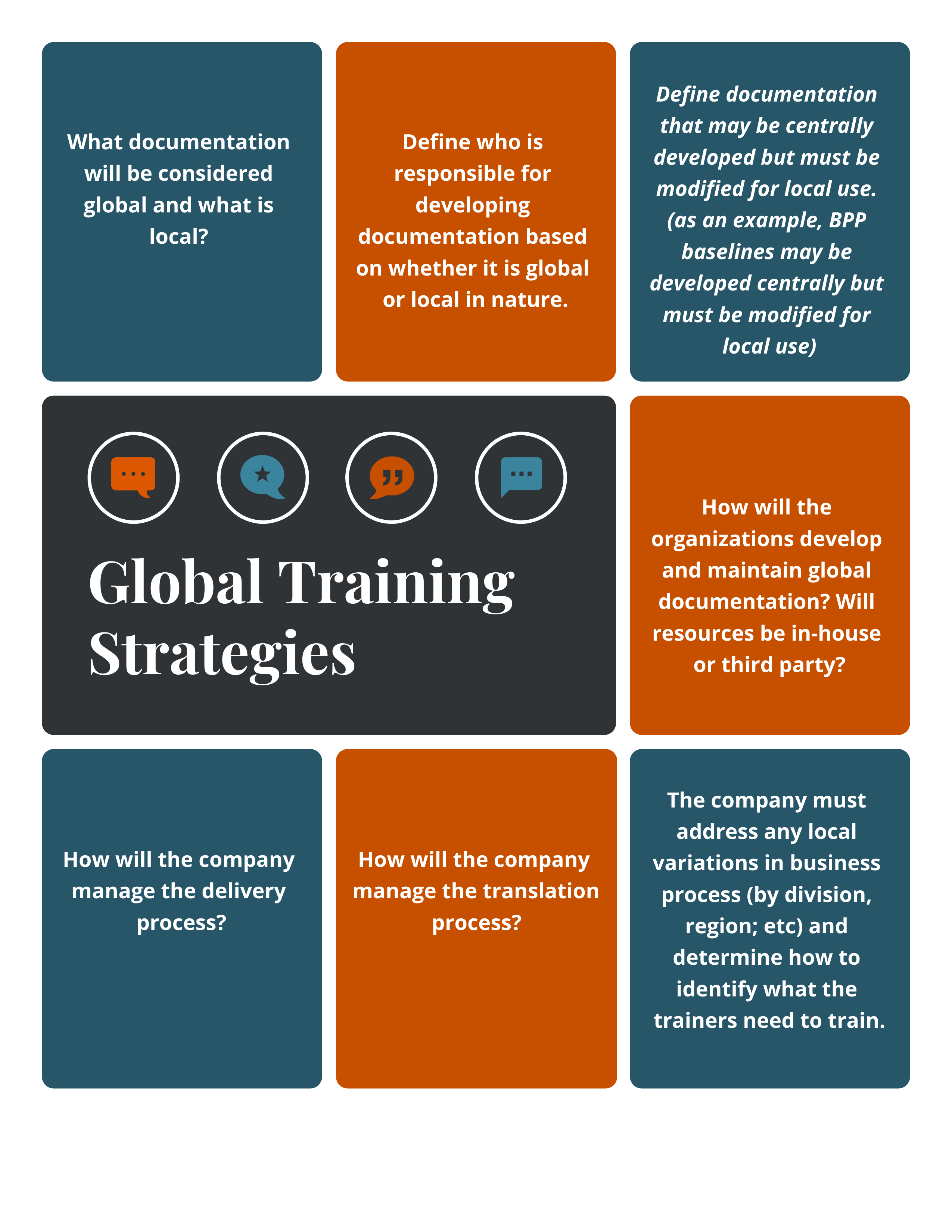
Global Training Strategies
9.Release Strategy
As businesses are converted, there will be continual releases, hotpacks, new functionality and version upgrades of the software. A strategy will have to be designed to keep the software up to date but yet allow implementation projects and LIVE conversions to continue. This is a critical planning and timing issue.
- Define the regression testing strategy required during a phased approach in which multiple businesses are in production while others are still in the implementation phases.
- Determine whether a regression testing tool is required. Management of regression testing during a phased global implementation is a challenging task and automated tools that manage and track this process can help.
- Define the request and approval process for transports moving to a production environment after the first LIVE conversion.
- Define the key personnel required for upgrade projects; additional resources may be required outside of the normal staff of implementation and maintenance support employees.
10. Global System Support
- Define strategy and design options for a production support organization in a global environment; consider times, service level agreements, local support processes as first level of support.
- Ensure that there is local infrastructure in place for network development and hardware deployment. If not available in remote regions, a strategy must be defined to support these areas.
- What metrics will be used to assess performance?
- What logging and tracking methodologies will be used?
- Examine the level of technology readiness of the company for this global implementation. (i.e., IVR, scanning of resumes, on-line ad hoc reporting)
- Determine whether the same technology solutions be used in all locations.
- Determine the global support infrastructure that needs to be put in place to service the new system. Consider the following areas:
-
- Help Desk
- DBA Function
- Backup/Recovery
- Maintenance
- Enhancements
- Software Distribution
- Performance
- Hardware Support

Global System Support
11. Single Instance vs. Multiple Instance Approach
Componentization provides a company with the flexibility to implement SAP HR on a standalone or a distributed system, independent from the other enterprise applications.
An optimal instance strategy (that is, the definition of how many instances, where they are located, and how they are interconnected) must be determined; the most common business objectives to be obtained in such an analysis are:
- Legal compliance
- Process and data seamlessness
- Application management and service feasibility
- Cost effectiveness

Single Instance vs. Multiple Instance Approach
12. Data Conversion
Global Data Conversion Process and Conversion of Historical Data.
Benchmarks must be run to determine the expected conversion times for master and organizational data. Data entry delays can be kept to a minimum if data is loaded in careful priority and integration testing is thorough and well executed.
13. Data Privacy
European Data Protection Laws and Cross-Border Data Flow
While the United States and the European Union share the goal of enhancing privacy protection for their citizens, the United States takes a different approach to privacy from that taken by the European Union. The United States uses an approach that relies on a mix of legislation, regulation, and self-regulation.
The issues surrounding the directive and their impact on global systems has been significant. Companies have to define, at a corporate level, a data privacy strategy that meets the requirements of the countries involved.
-
What are the Top Challenges in Implementing a Global HR System?
The Top Challenges in Implementing a Global HR System includes Integration with Existing ERP System, Global Process Management, Global Communication Strategies, Global and Team Organization, Cross-Cultural Processes, Global Change Management, Master Data Management, Global Training Strategies, Release Strategy, Global System Support and many more.

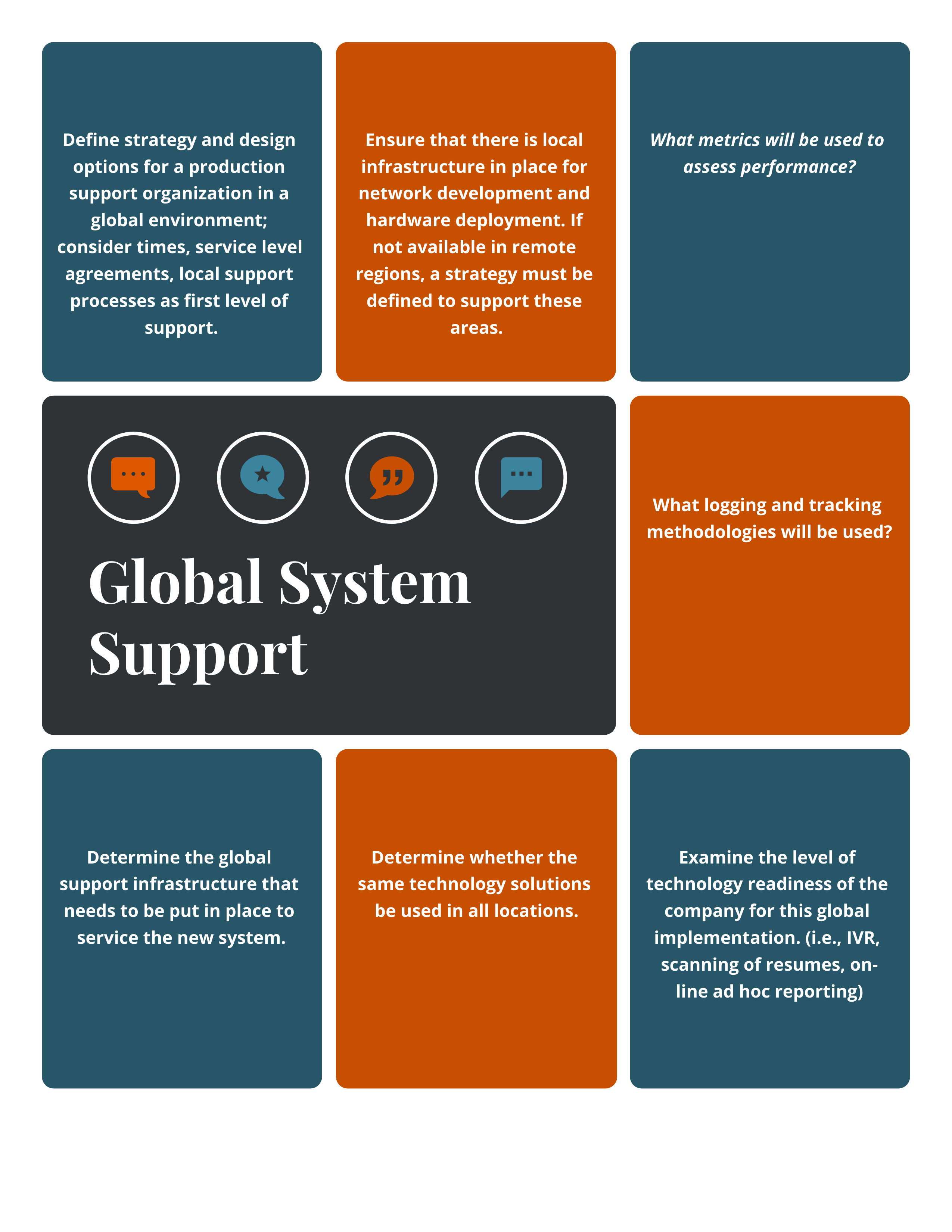

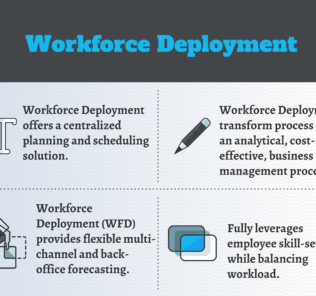
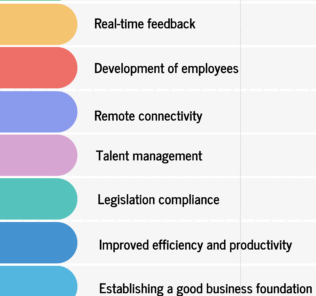
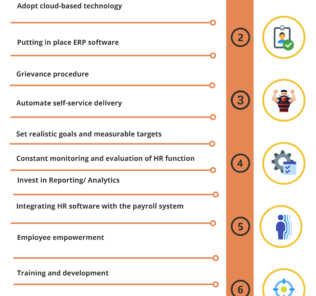
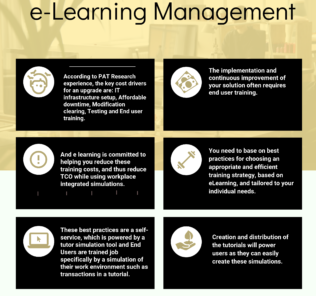
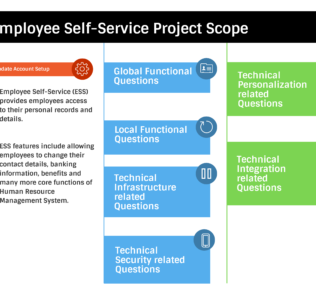





By clicking Sign In with Social Media, you agree to let PAT RESEARCH store, use and/or disclose your Social Media profile and email address in accordance with the PAT RESEARCH Privacy Policy and agree to the Terms of Use.